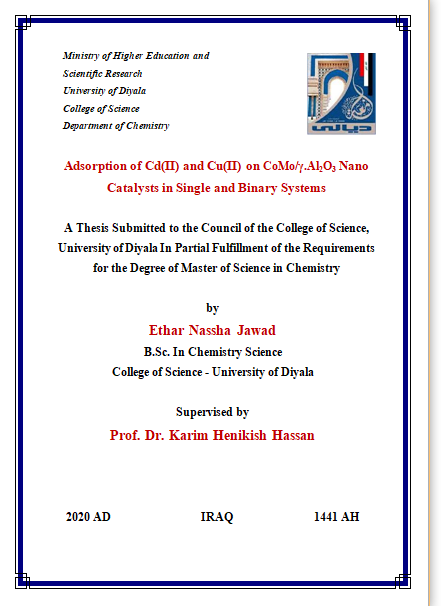Abstract
In this study, the Nano γ.Al2O3, support was prepared by Co-Precipitation method from Aluminium Chlorides hexahydrate (source of Aluminum) and calcination at temperature off 550 ºC. Then Nano CoMo/γ.Al2O3 Catalyst was prepared by impregnation method were Cobalt nitrate (source of Cobalt) and ammonium hepta Molybdate (source of Molybdate) on the prepared Nano of γ.Al2O3 support with Calcination at a temperature 550 ºC.
They are characterized by X-ray diffraction spectrometry (XRD) and energy-dispersive X-ray spectrometry (EDX). Field Emission Scanning Electron (FESEM). Atomic force microscope techniques (AFM). XRD spectrum reveals that particle size obtained is about (4.33) nm for (γ.Al2O3) and (5.2) nm for prepared (CoMo/γ.Al2O3), which agreed fairly well with AFM.
Water pollution with many heavy metals is a major damage for environment, therefore the CoMo/γ.Al2O3 nanoparticles prepared are used to remove cadmium and copper ions in binary system from dilute aqueous solution.
In this field, a number of factors have been studied for effect the percentage removal of metals in binary system into adsorbents, the time required to remove Cd+ and Cu+2) ions, in binary system to reach equilibrium was studied and showed that contact time were (15) min for removal of two metals of on CoMo/γ.Al2O3 surfaces. The removal of cadmium (II) and copper (II) ions was found to be slightly reduce by increasing the concentration of adsorbate and increase by increase the weight of the surface, studying the adsorption of cadmium and Copper ions in binary systems, at different values of pH (2, 4, 6 and 8) indicated that the best adsorption of two heavy metals on surfaces prepare at pH 6 whereas the effect of temperature on each metals removal in binary system showed that the percentage removal is reduced by increasing the temperature, which means that the process is at exothermic.
Calculated values of the thermodynamic functions of the adsorption process, such as (∆G, ∆H, and ∆S), indicates the process of adsorption is spontaneous, exothermic and less randomness at metals binary ion-metal oxide nanoparticles.





